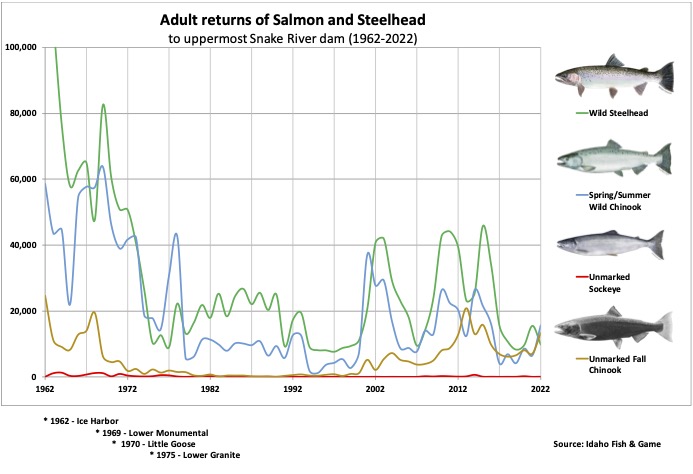forum
library
tutorial
contact

A Look at the Fight Over
Snake River Dams at Thirtysomething
by Randy Stapilus
Lewiston Tribune, November 6, 2023
|
the film forum library tutorial contact |

|
A Look at the Fight Over
by Randy Stapilus
|
It's hard to conceive that there's much new left to talk about.
 When the Snake River Basin Adjudication was begun in 1987, no one expected it would be completed quickly. Water adjudications in Western states often have taken decades, and the SRBA may have been the largest ever, covering six figures worth of water rights across almost nine-tenths of Idaho.
When the Snake River Basin Adjudication was begun in 1987, no one expected it would be completed quickly. Water adjudications in Western states often have taken decades, and the SRBA may have been the largest ever, covering six figures worth of water rights across almost nine-tenths of Idaho.
Nonetheless, it has been completed -- at least in general terms -- and it only took a remarkably brief 26 years.
That bit of history prowled around the back of my mind this week when I saw the latest court developments in the legal action aimed at breaching the four lower Snake River dams, located in southeastern Washington. The dams are the Lower Granite (closest to the Idaho border), the Little Goose, the Lower Monumental and the Ice Harbor (near the confluence with the Columbia River).
The news involves a delay in further developments, which is to say, another in a long list of delays of anything resembling final action. Specifically, the parties involved asked the court for another 45 days to negotiate, following up on an earlier delay of 60 days.
Those are a pittance. The legal action over the four dams started in 1993, which means attorneys have been kept busy on the subject for 30 years -- three years longer than it took to adjudicate the highly complex and contentious water rights across most of Idaho.
It's hard to conceive that there's much new left to talk about.
The issues associated with the dams (and I'm not going to try to relitigate them all here) mainly concern preservation of declining salmon runs on one hand, and the electric power the dams generate and concerns about impacts on commercial river traffic -- you'll hear this a lot at Lewiston -- on the other. Environmental, tribal and some governments have been on one side, and a number of federal agencies, economic interests and others have filled the other. The region, and many of its top elected officials, have been split -- and within the parties as well as between them.
One report from the University of Washington said, "Despite research and knowledge of the effects of the LSRDs on salmon and steelhead populations, river ecology, and tribal sovereignty there remains resistance at the state and federal level. The barrier to remove the LSRDs for Governor (Jay) Inslee (D) of Washington is the fact that the dams produce renewable energy, recreational, and economic benefits. However, both Gov. Inslee and Senator (Patty Murray) have been open to exploring the possibility of removing the dams if the benefits and services the dams create can be replaced by alternatives."
Yale School of the Environment noted that over the last three decades, "On at least five occasions, federal judges ordered the agencies to consider removing the lower Snake River dams, and each time the agencies responded with delay and diversions, once going so far as to call the dams immutable parts of the landscape, and therefore not subject to the Endangered Species Act."
Neither side seems inclined to quit.
Still, after 30 years, the context of the legal battle has changed, and the changes may suggest where this is heading.
First, in the last decade, the debate has taken place in the context of demolition of a number of other dams in the region.
Second, the dams need repairs if they're going to continue in service, and that will be costly.
Third, renewable energy -- notably solar and wind -- has taken off in a big way in the Inland Northwest, and the argument that the dams are needed for their electric power generation has become less central in the debate.
It could be that if the parties come to accept some of the trend lines, and not just the starting and hoped-for ending points, the case could be resolved before another 30 years has passed.
Related Sites:
All Our Nations Campaign by Native Organizers Alliance, 10/1/23
learn more on topics covered in the film
see the video
read the script
learn the songs
discussion forum
